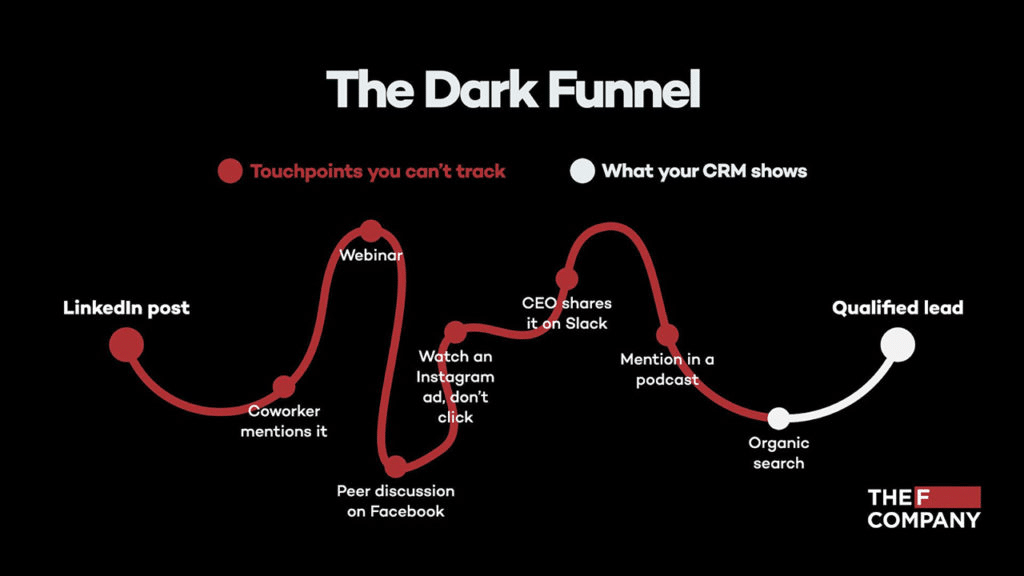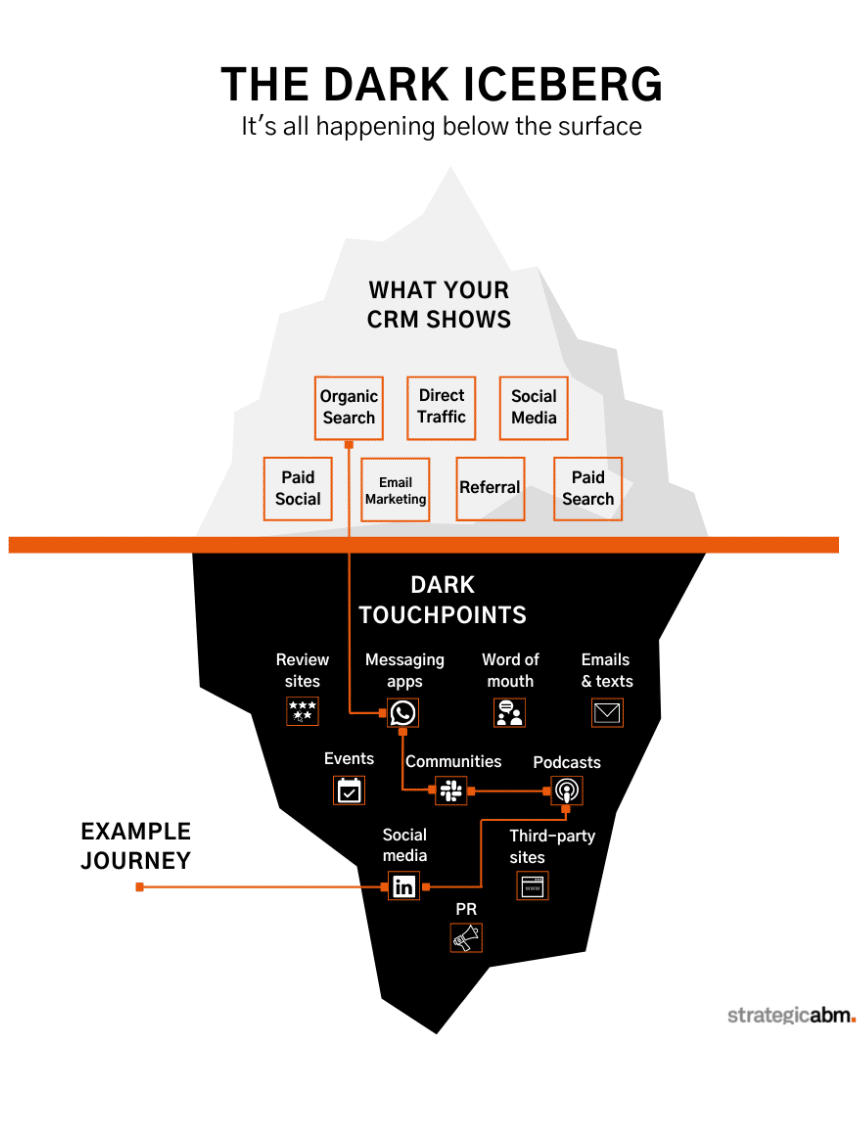As the marketing sphere evolves, mastering consumer behavior and optimizing the buyer’s journey are pivotal for thriving in the competitive market. Traditional marketing funnels, however, often fail to capture the full breadth of consumer interactions.
Enter the enigma of the dark funnel. This term pertains to elusive channels and touchpoints where potential buyers engage with your brand, playing a crucial role in advancing them along the buyer’s journey.
In this piece, we will unravel the complexities of the dark funnel, scrutinize its impact on customer journeys, underscore its significance in contemporary marketing strategies, and offer actionable insights to harness its power.
What is the dark funnel?
The dark funnel represents various activities throughout a buyer’s journey that marketers are unable to track, such as anonymous website visits, recommendations through private conversations, offline engagements, and unattributed sharing of brand content. These actions happen on channels and platforms that lack the conventional tracking mechanisms typically found in traditional marketing analytics.
Decoding the dark funnel
In the realm of the dark funnel, the term “dark” describes the unclear nature of certain untracked channels and touchpoints where potential buyers interact with a brand. These interactions occur beyond the reach of conventional tracking methods, posing a formidable challenge to marketers trying to collect accurate data and attribute specific actions to these touchpoints.
The obscurity of the dark funnel stems from the inability of marketers to directly observe or measure these interactions. Unlike activities within the visible stages of the sales funnel, where data can be harvested through cookies, tracking pixels, or user registrations, the dark funnel operates in shadowy territories.
This lack of transparency poses a significant challenge to marketers, hindering their ability to accurately assess the efficiency of their marketing strategies, comprehend the impact of various touchpoints on the buyer’s journey, and refine their campaigns. To dispel the gloom of the dark funnel, marketers need to harness innovative strategies and advanced technology to decipher insights from these elusive interactions.
By adopting cutting-edge tracking and attribution solutions, instituting referral programs, and leveraging cross-channel analytics, marketers can illuminate the dark funnel and delve deeper into how these concealed touchpoints sculpt the buyer’s journey.
The dark funnel’s influence on buyer journeys
The dark funnel, with its elusive channels and touchpoints, has a significant sway on buyer journeys in today’s digital world. It caters to the modern, nonlinear, and unpredictable nature of these journeys and plays an integral role in contemporary marketing strategies, particularly in B2B marketing scenarios.
Comprehending the dark funnel is essential for marketers. It offers valuable insights into customer behavior, interests, and preferences, helps improve personalization and targeting, and boosts the efficiency and effectiveness of marketing campaigns. Ignoring the dark funnel can lead to missed opportunities and inefficient marketing strategies.
The dark funnel molds the buyer’s journey by capturing unattributed interactions that occur outside the conventional marketing funnel.
To illustrate, consider a model journey of a prospective buyer, Sarah.
- Sarah learns about a B2B software company through a colleague’s word-of-mouth referral.
- Intrigued, Sarah visits the company’s website anonymously, and watches a demo video.
- She also reads customer reviews on third-party review sites.
- She later attends a trade show where she engages in offline conversations with company representatives.
- After receiving a personalized email offer, she accesses a gated whitepaper.
- Eventually, after extensive research and consideration, Sarah contacts the company’s sales team directly to make a purchase.
In this illustrative journey, the dark funnel encompasses various touchpoints that are tough to track. Sarah’s anonymous website visit, review investigation, offline conversations, and email engagement all reside within the dark funnel – and so does the referral her colleague made initially. These interactions significantly impact her decision-making process, propelling her along the buyer’s journey.
Without the understanding and consideration of the dark funnel, marketers would have a limited view of Sarah’s actions, making it challenging to accurately attribute the success of their marketing endeavors.
Accommodating modern, nonlinear, and unpredictable buyer journeys
Today’s consumers have an abundance of resources at their disposal and multiple touchpoints through which they gather information, seek recommendations and engage with brands. They can jump between online and offline channels, conduct extensive research, and rely on peer recommendations. The dark funnel acknowledges this complexity and provides a framework to understand and leverage these hidden interactions.
Importance of understanding the dark funnel in modern marketing strategies
In B2B scenarios, understanding the dark funnel is particularly important due to the typically longer and more complex sales cycles. Buying decisions involve multiple stakeholders, extensive research, and interactions across various touchpoints. The dark funnel captures untrackable actions that can significantly influence these buyer journeys, such as private conversations, referrals, and offline engagements. By understanding and leveraging the dark funnel, marketers gain a comprehensive view of these complex B2B buyer journeys and can tailor their strategies accordingly.
Harnessing the dark funnel in the era of digital transformation
Digital transformation has accentuated the significance of the dark funnel in contemporary marketing. The surge of digital channels, social media, online communities, and mobile communication has broadened the opportunities for elusive interactions.
Potential buyers can engage with brands through private messaging, direct referrals, and sharing content in untraceable manners. Digital transformation has blurred the lines between marketing and personal communication, making it imperative for marketers to demystify the dark funnel and harness its insights.
Shining a light on the dark funnel gifts marketers a profound understanding of customer behavior and interests. By analyzing elusive interactions, marketers can identify patterns, preferences, and pain points of their target audience. This knowledge equips them to craft more engaging, personalized marketing campaigns that resonate with customers, delivering bespoke content, offers, and experiences that align with individual prospects’ specific needs and preferences, ultimately bolstering engagement and conversion rates.
Moreover, insights gleaned from the dark funnel empower marketers to enhance personalization and targeting. By understanding the elusive touchpoints that influence buyer behavior, marketers can refine their messaging, segment their audience more effectively, and deliver highly targeted content at the right time through the most suitable channels. This level of personalization not only boosts conversion chances but also enriches the overall customer experience, fostering long-term loyalty and advocacy.
Consequences of ignoring the dark funnel
Neglecting the dark funnel can have grave repercussions for businesses. By disregarding elusive interactions and touchpoints, marketers miss golden opportunities to engage with prospects, influence their decision-making process, and establish meaningful relationships. Without a comprehensive understanding of the buyer’s journey, marketers run the risk of misallocating resources, targeting the wrong audience segments, and delivering irrelevant messages. This can result in missed conversions, decreased marketing ROI, and ultimately, a competitive disadvantage in the marketplace.
Dark social vs. the dark funnel
While both dark social and dark funnel bear an intriguing resemblance due to their interconnected channels of operation, their focus areas and extent differ markedly. Dark social pertains to the untracked distribution of a brand’s content. It happens when users circulate content through private channels like instant messaging apps, emails, or direct sharing, bypassing trackable elements like social share buttons. The term “dark” in dark social signifies the complexity in precisely tracking and measuring these engagements, as they elude traditional analytics tools.
Conversely, the dark funnel transcends mere content sharing. It includes not only untracked content dissemination but also unobservable actions that mold opinions and propel individuals through the buying cycle. These may include anonymous site visits, offline discussions, referrals, and other touchpoints that defy direct attribution to marketing campaigns. The dark funnel illuminates the entire inscrutable buyer journey, striving to decode the obscured pathways buyers traverse.
Dark social and the dark funnel typically unfold on similar channels, with direct messaging being a predominant one. Users may disseminate content or engage in dialogues through private messaging apps or platforms, which offer a more personalized and intimate communication environment, apt for dark social and dark funnel interactions.
While dark social focuses on the untracked sharing of content, the dark funnel the wider set of is broader, and involves all unobservable actions influencing consumer behavior. Marketers can glean insights from dark social to pinpoint audience preferences, future content ideas, and potential influencers. Conversely, the dark funnel offers a holistic perspective of the unattributed touchpoints and exchanges steering individuals through the buyer journey.
By discerning the similarities and contrasts between dark social and the dark funnel, you can devise strategies to effectively harness both. You can employ tracking solutions, referral programs, and attribution models to glean insights from dark social sharing, while also unraveling broader unobservable actions influencing consumer opinions and driving conversions in the dark funnel.
Integrating the dark funnel into your marketing strategy
For optimized marketing efficiency, it’s crucial to weave dark funnel insights into the overarching marketing strategy. Content marketing plays a pivotal role in captivating potential customers within the dark funnel. By crafting valuable, sharable content that strikes a chord with prospects, marketers can enhance organic sharing, extending their brand’s reach.
Personalization is equally vital. Dark funnel insights disclose a wealth of information about customer preferences and interests. Utilizing this data allows marketers to customize their messaging, offers, and experiences for individual prospects, bolstering engagement and conversion rates.
It’s essential to underscore that dark funnel strategies mandate a continuous refinement approach. As insights accumulate, it’s crucial to adapt marketing endeavors based on these findings. Regular analysis and optimization ensure marketers remain in tune with shifting buyer behaviors and tastes.
Applying best-practice marketing tactics to the dark funnel
Even if you can’t track the actions people take in the dark funnel, your business can take these actionable steps to align its marketing efforts with those actions:
- Create expert content to build trust, build your brand, and encourage social media sharing.
- Create content based on audience needs, as identified through voice of customer listening – even if you can’t track engagement with the content, it will make a difference in the dark funnel if it speaks to customer needs.
- Create content that covers all stages of the buyer’s journey, using a variety of content channels and mediums
- Build a top-notch customer experience that gets people talking about you.
- Talk to your existing clients to learn how they heard about you – then if several mention a dark funnel source, optimize the content on that channel.
Steps to forge a dark funnel-driven marketing strategy
Aligning marketing initiatives with dark funnel actions requires businesses to adopt actionable steps that exploit technology, analytics, and strategic tracking techniques. By following these steps, businesses can delve into untrackable interactions, streamline their marketing strategies, and elevate customer engagement:
Harnessing technology and analytics
To demystify the dark funnel, businesses must implement cutting-edge technology and analytics tools. Advanced tracking and attribution software solutions can surpass traditional analytics and unearth insights about untrackable touchpoints, anonymous site visits, and offline engagements.
By leveraging these tools, businesses can effectively draw the connection between customer interactions and their impact on the buying process. These technologies empower businesses to capture and scrutinize data from the dark funnel, enabling them to understand customer behavior, finetune marketing strategies, and enhance the overall efficacy of their campaigns.
Monitoring dark funnel activities
To proficiently monitor dark funnel activities and unearth insights about untrackable interactions, businesses can take several steps:
Initiate referral programs: Motivate customers to recommend your brand or products to their network by offering appealing incentives and rewards. A referral program encourages word-of-mouth sharing in a way you can track – and referral software costs much less overall than other dark funnel illuminating tools.
Using referral software (like Referral Rock), you can create distinct referral links or codes that can be tracked to identify the source and effect of referrals on the buying journey. By monitoring and examining these referrals, businesses can unravel dark funnel insights and comprehend the influence of word-of-mouth marketing on conversion rates.
Include UTM links in offline campaigns: When executing offline marketing campaigns, integrate unique URLs with specific UTM parameters. These parameters help monitor the traffic and engagement generated from offline touchpoints once they’re entered online. Analyzing the collected data can disclose normally untrackable actions, like visits to specific landing pages from print advertisements or direct mailers.
Embed tracking pixels: Incorporate tracking pixels across various digital touchpoints, including websites, landing pages, and email campaigns. These pixels enable businesses to gather data on user behavior, such as page visits, clicks, and conversions. Analyzing this data offers insights into untrackable actions within the dark funnel, helping identify touchpoints that exert the most impact on the buyer’s journey.
Consider machine learning tools for predictive analytics: Predictive analytics tools (sometimes called intent data tools or dark social tools) can help predict leads that will come from “dark” sources. Be mindful, though, that these tools can be expensive.
Other steps you can take to track dark funnel actions include the following:
- Take advantage of social listening to pick up on brand conversations, and possibly find untrackable sources of traffic to your site
- Add tracking codes to as much of your social-shared content as you can – then use link shorteners so people can’t see and remove the tracking parameters when sharing.
- Check your analytics for “direct” traffic – if you’re getting a lot of direct traffic on an article, that may actually be coming from dark sharing
By adopting these steps, businesses can attain a profound understanding of the dark funnel and the untrackable actions occurring within it. Monitoring dark funnel activities allows businesses to gauge their marketing efficacy, pinpoint influential touchpoints, and make data-driven decisions to enhance their strategies for improved customer engagement and conversions.
The takeaway
Understanding and leveraging the dark funnel is a game-changer for marketers in today’s dynamic landscape. By acknowledging hidden buyer journeys and untrackable interactions, businesses can unlock a competitive edge. Incorporating dark funnel insights into marketing strategies empowers marketers to curate personalized experiences, refine targeting, and fuel conversions. Despite the challenges, the potential benefits of embracing the dark funnel, such as enriched customer insights and optimized marketing endeavors, are substantial. It’s high time for marketers to seize this opportunity and adapt their strategies accordingly to excel in the era of the dark funnel.







